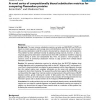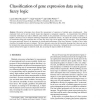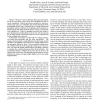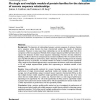376 search results - page 31 / 76 » Multiple Sequence Alignment using Fuzzy Logic |
BMCBI
2008
13 years 7 months ago
2008
Background: The most common substitution matrices currently used (BLOSUM and PAM) are based on protein sequences with average amino acid distributions, thus they do not represent ...
JIFS
2002
13 years 7 months ago
2002
Microarray technologies have allowed the measurement of expression of multiple genes simultaneously. Gene expression levels can be used to classify tissues into diagnostic or progn...
BROADNETS
2005
IEEE
14 years 1 months ago
2005
IEEE
—The peer-to-peer technology offers many advantages, but at the same time, it poses many novel challenges for the research community. Modern peer-to-peer systems are characterize...
BMCBI
2006
2006
On single and multiple models of protein families for the detection of remote sequence relationships
13 years 7 months ago
Background: The detection of relationships between a protein sequence of unknown function and a sequence whose function has been characterised enables the transfer of functional a...
BMCBI
2004
13 years 7 months ago
2004
Background: Existing sequence alignment algorithms assume that similarities between DNA or amino acid sequences are linearly ordered. That is, stretches of similar nucleotides or ...




